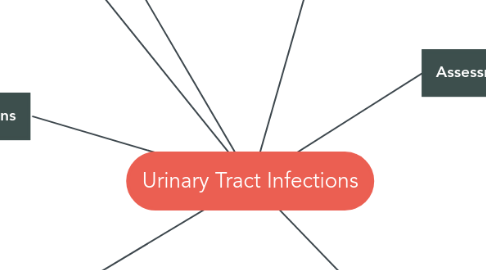Urinary Tract Infections
by Kiersten Bair


1. Urinary System
1.1. Functional Health Pattern
1.1.1. Elimination
2. Nursing Diagnosis
2.1. Altered urinary elimination related to infection.
2.2. Acute pain related to infection
2.3. Self-care deficit related to urinary tract infection.
2.4. At risk for injury to urinary tract related to indwelling catheter as evidenced by urinary tract infection.
3. Tests
3.1. Urine culture
3.1.1. This test involves identifying microorganisms that are present in a patient's urine sample.
3.2. STI tests
3.2.1. A UTI can be transmitted sexually.
3.3. CT Scan
3.3.1. This imaging test can detect pyelonephritis.
4. Nursing Interventions
4.1. Encourage patient to void frequently to empty the bladder completely. This can reduce the amount of bacteria in the urine.
4.2. Administering analgesics and application of heat pad can help relieve pain.
4.3. Educate patient on urinating after taking baths and sexual intercourse. Educate patient on use of cotton underwear.
5. Pathophysiology
5.1. The urinary tract, from kidney to urethral meatus, is sterile and resistant to bacteria. However, a UTI can occur when bacteria ascend the urethra and bladder and colonize, causing infection.
5.1.1. Escherichia coli
5.2. This infection causes painful urination, flank pain, hematuria, and bacteriuria, dysuria
5.3. May lead to pyelonephritis, cystitis, and systemic infection.
6. Assessment
6.1. Assess changes in patient's urinary urgency and frequency.
6.2. Assess patient's knowledge about preventing UTIs and how they occur.
6.3. Assess patient's urine: color, concentration, odor, and volume.
7. Complications
7.1. Renal failure
7.1.1. Bacteria can spread throughout the entire urinary system.
7.2. Sepsis
7.2.1. Bacteria that invades the urinary system can result in the bacteria entering the bloodstream, causing sepsis.
